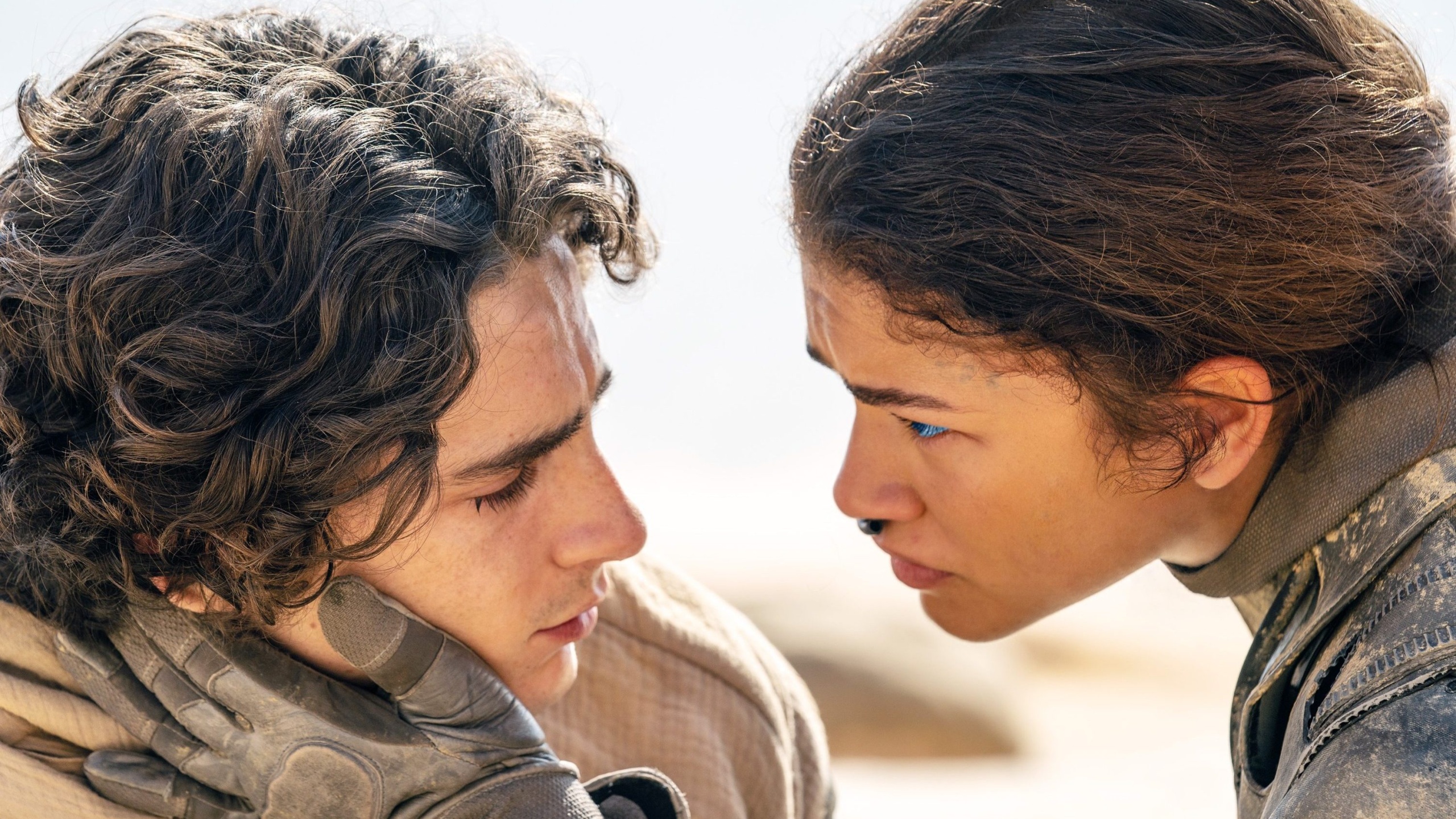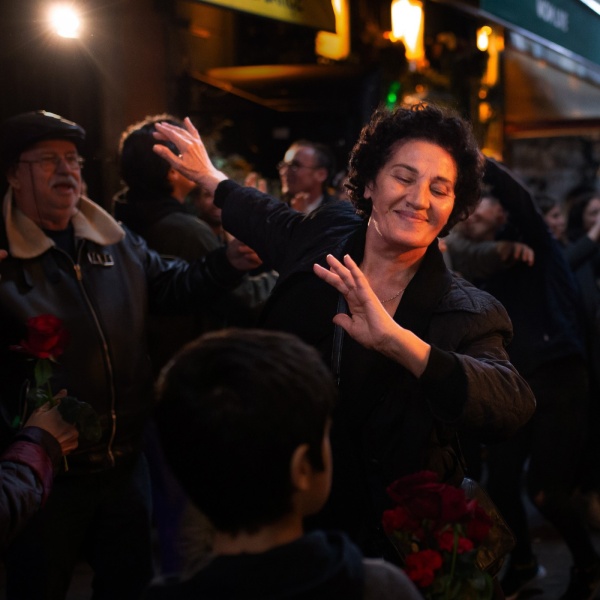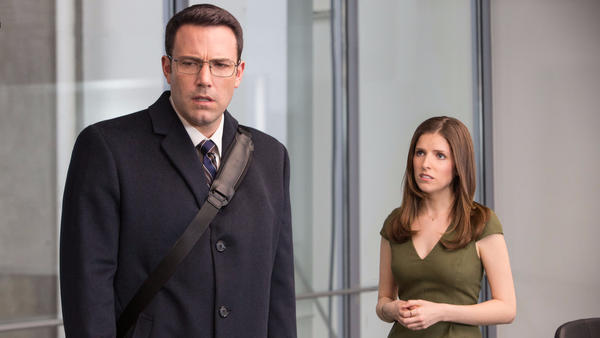Denis Villeneuve has insisted that “Dune: Part Two” would be a direct continuation of its predecessor rather than a sequel, and the man has absolutely made good on that promise: Not only does this new movie pick up exactly where the last one left off, it also carries over the strengths and weaknesses that made the previous chapter so astonishing to look at but stultifying to watch.
Once again, Frank Herbert’s sand-blasted spice opera has been adapted at a scale that makes the average Hollywood blockbuster seem like a shoebox diorama by comparison, and while the last “Dune” was compromised by Warner Bros. brass’ decision to sacrifice it at the altar of a streaming platform that no longer exists, “Part Two” is poised to thunder into multiplexes around the world like the Shai-Hulud swimming through a dry ocean full of desert mice.
Once again, the biblical solemnity of Villeneuve’s approach — along with the tactile brutalism of his design — have combined into a Timothée Chalamet movie that shimmers with the patina of an epic myth. And once again, the awesome spectacle that Villeneuve mines from all that scenery is betrayed by the smallness of the human drama he stages against it, with the majesty of the movie’s first hour desiccating into the stuff of pure tedium as Paul Atreides struggles to find his voice amid the visions that compel him forward. It’s a struggle that “Dune: Part Two” continues to embody all too well.
This isn’t quite the same common — and admittedly boring — criticism that’s been leveled against massive studio movies since the industry first started making them. This isn’t a case of sound and fury signifying nothing, or one of special effects signifying even less. The artistry of this film’s craftsmanship and the sincerity of its application would in and of themselves make it disingenuous to compare “Dune: Part Two” to the likes of, say, “Jurassic World” and Disney’s “live-action” remake of “The Lion King.”
But there’s a more important distinction at play: Where those creatively bankrupt examples — motivated by desperate market forces — suffered from the mistaken belief that the future is a foregone conclusion no matter how awful it looks, “Dune” is an auteur-driven story about a reluctant messiah who’s tortured by his role in a terrible prophecy that only he has the power to stop. And yet, we’re never given any reason to think that Paul might actually do it, or even to care if he can.
If “Dune: Part Two” is more nuanced and action-packed than the previous installment, and Chalamet’s twiggy princeling a far less passive hero than he was the first time around, the relative density of the drama that Villenueve has packed into this movie is deflated by a similar uptick in the grandiosity of the spectacle that surrounds it. Much like his protagonist, the filmmaker is straining to reconcile a larger-than-life sense of predestination with the intimate pain of a moral dilemma, but his own failure to achieve that balance makes it all but impossible for Paul to succeed on the same terms.

The droning heaviness of Villeneueve’s direction is great at creating a sustained mood (in this case, one of mournfully pyrrhic victory), but it flattens characters into the sets around them until they start to feel like part of the scenery themselves. It’s as difficult to trace the granular changes in Paul’s thinking as it would be to notice a single chip in the giant slabs of gray concrete that form the gladiator arena on Giedi Prime (Chalamet’s gradual transition from reverent whisper-talking to empyrean scream-shouting is the closest thing we get to legible character growth), and that lack of detail becomes a fittingly enormous problem for this film as the transportive stage-setting of its first half gives way to the stunted fatalism of its second.
Yes, this is a vaguely Oedipal tragedy about a manchild lurching towards the same violent outcome that he’s so determined to avoid (you’ll have to wait for the not-yet-announced but inevitable “Part Three” to see how that plays out), and of course there’s an ancient power in the story of someone fighting against the fate that’s been written for them. But the iron grip of that inevitability should only make it more heart-wrenching to follow Paul as he tries to find his role among the Fremen of Arrakis and avenge his father without instigating an intergalactic holy war.
Instead, Paul’s growing prescience becomes a major albatross for a film too focused on the big picture to look for signs of life in each scene along the way, and watching this boy-god arrive at the only possible future among the many that he learns to foresee is as dull and emotionally disengaging as it was to watch him awake to that destiny in the first “Dune.” “Part Two” may be the more broadly entertaining of these two movies, but feeling unmoved by the climactic sight of Willy Wonka riding a 400-meter sandworm into battle against a Manhattan-sized disco ball is also a much weirder and more uncomfortable kind of disappointment than anything the last chapter had to offer.

This time, however, the road towards that colossal letdown is a bit smoother. Villeneuve and co-writer Jon Spaihts have already teased out the lay of the land, and so “Dune: Part Two” is able to dig a little deeper from the moment it starts — to actually show us some of the places that were alluded to in the previous movie, and to complicate the white savior myth that Paul brings with him when he and his pregnant mom (Rebecca Ferguson as Lady Jessica) are escorted to the secret Fremen community of Sietch Tabr.
As usual, Villeneuve thrives in the world-building of it all. Few directors who operate at his scale — and there are only a few directors who operate at his scale — are as skilled at framing bodies against the vastness of blank space, and we intuit more about the history of Arrakis from Patrice Vermette’s awe-inspiring sets than we do from anything the characters have to say about it. Watching Paul walk through the Fremen’s half-buried homestead tells us everything we have to know about the urgency of their fight for survival against the Harkonnen colonizers who’ve pillaged their planet for its spice, and when Lady Jessica is forced to ingest “centuries of pain and sorrow” in order to become the Reverend Mother under penalty of death, we can imagine what that tastes like.
These early scenes represent the very best of what Villeneuve can bring to this story, as they viscerally bring to life “a place where nothing can live without faith.” It’s because the arid deserts are so merciless that we can understand why the Fremen suck the moisture out of their enemies’ bodies and honor their own dead by pouring their water into a giant pool, and it’s because of an indelible new track from Hans Zimmer’s semi-recycled score — a bittersweet wail that cuts deeper than any of the music he wrote for “Part One” and sustains the emotion of this movie long after the script has run out of steam — that we can parse the complicated roles that anger, pride, and resentment play in the Fremen’s need for outside help.

That clarity lends a welcome shot in the arm to the thrilling action sequences that Villeneuve stages on the sand, which are clear and concussive enough to compensate for their brevity. These setpieces — which peak with a sandworm-riding trial so exhilarating that the rest of the movie can’t help but feel like a letdown — are also more exciting than anything that follows because they allow Paul to forge his relationship with the two Fremen who will most directly impact his fate.
Both of them made brief appearances in the last “Dune,” and both of them use that head start to make far greater impacts than any of the characters who are first introduced in “Part Two.” The first is the Fremen tribal leader Stilgar, a wincing zealot who puts all of his shaken faith in the belief that Paul might be the chosen one prophesied to save his people. Javier Bardem’s broken smile of a performance brings a much-needed tenderness to a movie full of hard geometric shapes, and his humor masks the kind of desperation that Villeneuve’s steely remove tends to snuff out along with any other raw emotion (when was the last time someone managed to be this light and funny in one of his films?).
And then, of course, there’s Chani. The skeptical and self-reliant Fremen was the patron saint of everything that didn’t work about the last movie, as Spaihts and Villeneueve reduced her character to a living reminder of all the sacrifices their adaptation had to make on its way to the screen. In “Part Two,” Chani is allowed to take her rightful place at the heart of Paul’s story, even as she questions whether or not it should belong to him (and even as the script dramatically streamlines her role in it).
Zendaya is more than up for the challenge. Not to belittle Chalamet, whose furrowed brow sows doubt in all the right places, but the most interesting thing about Paul’s trajectory is how it’s reflected across Zendaya’s face. So much of this increasingly interminable film is spent on slow-motion shots of silhouettes walking towards the sunset as Zimmer goes ham over the soundtrack, but all it takes is a single reaction shot of Chani for the drama to snap back into focus.

This “Dune” is never better than when it frames its messianic spectacle as the backdrop for a star-crossed love story about a woman falling in love with the same man she doesn’t trust to free her people. Villeneuve’s “Dune” has almost nothing new to say about religion as a form of control, or the risks that an indigenous community might incur by trusting their salvation to a white boy from another planet, but none of that seems to matter when it all comes down to a couple of people who lose sight of the signs whenever they look at each other.
And bless the Maker and his water for that, because as soon as “Dune: Part Two” begins to shift its attention away from the Sietch, palpable emotion becomes as precious and hard to find in this movie as moisture in the deserts of Arrakis. The problem starts with the villainous Harkonnen, who are somehow even less compelling here than they were in the previous movie. Parodies of colonial evil, these hairless world-eaters are such one-dimensional rage cases that they make the Sith feel almost Shakespearian by comparison. Dave Bautista still cuts quite a figure as Glossu Rabban Harkonnen, but his entire character amounts to a distended scream — there are no fewer than three scenes in this movie where Rabban or one of the other Harkonnen murder a henchman just to release some steam.
Stellan Skarsgård’s Baron Vladimir Harkonnen, who was such a monstrous force of nature in the previous “Dune,” is now a shadow of his former self, and so it’s up to his nephew Feyd-Rautha Harkonnen (Austin Butler, doing an excellent Skarsgård impression) to step up and lead the family to the promised land. Butler certainly doesn’t half-ass his transformation into a sexually vulnerable psychopath so white — or whiiiiiite — that Colonel Tom Parker would probably self-combust if he saw him, but his commitment to the part can’t redeem the fact that Feyd-Rautha is just a pasty knife-licking bore.

Villeneuve introduces him in a hideous, monochromatic fight sequence that so clumsily literalizes the film’s black-and-white moral binary that it feels like a detour into a Zack Snyder movie, and from that point on Feyd-Rautha never has a chance to rise above his look to become a rival worthy of Paul’s ascendance. His only scene that doesn’t bring “Part Two” to an absolute standstill involves Léa Seydoux dropping by for some light “Under the Skin” cosplay.
This Bene Gesserit-style seduction is one of the only moments in the film’s second half where things play out on a human scale, and — derivative as it might be — it stands out from the thundering numbness of what follows when the Emperor of the Known Universe decides to pay Arrakis a visit and settle the war between the houses once and for all. He’s played by a badly miscast Christopher Walken, whose natural affectations distract from a movie that’s in desperate need of a more grounded presence. Florence Pugh, by contrast, strikes the perfect balance between strength and survivalism in her brief role as the Emperor’s daughter, but her character is ultimately just a series of bejeweled headpieces in search of a narrative purpose. Like so much in this film, Princess Irulan is so amazing to look at that Villeneuve can only think to pose her.
The Emperor’s arrival is meant to reflect Paul’s discovery that power cannot be tamed, and that “the heart is not meant to rule,” but his non-presence only manages to incite one of the largest and most underwhelming final battles a sci-fi blockbuster of this scale has ever served up. That anticlimax may be true to the plot of Herbert’s novel, but it reflects the missteps of Villeneuve’s stolid adaptation. In a film so booming and immense that it seems like sandworms are rumbling under your feet, a film that best identifies with the Bene Gesserit’s detached and ultra-wide POV on this story, even the most significant events tend to blow over like farts in the wind. Even the oldest and most oft-told of myths feel more alive in the moment.
The pieces on this chess board are so big that we can hardly even tell when they’re moving, and while that sensation helps to articulate the sheer inertia of Paul’s destiny, it also leads to a shrug of an ending that suggests Villeneuve and his protagonist are equally at the mercy of their epic visions. No filmmaker is better equipped to capture the full sweep of this saga (which is why, despite being disappointed twice over, I still can’t help but look forward to “Dune: Messiah”), and — sometimes for better, but usually for worse — no filmmaker is so capable of reflecting how Paul might lose his perspective amid the power and the resources that have been placed at his disposal.
Grade: C
Warner Bros. will release “Dune: Part Two” in theaters on Friday, March 1.


